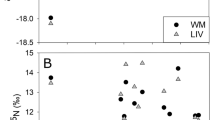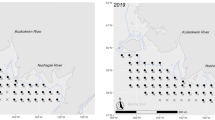Abstract
The ratio of 15N/14N (δ15N) from consumer and prey tissue is commonly used in ecological studies to determine trophic level, food web structure, and mean trophic level in aquatic ecosystems. There is a predictable positive relationship between the δ15N values in tissue and trophic level, caused by the bioaccumulation of 15N in tissues of consumers with each step up the food chain. Reconstructing trophic structure or food chain length over time may provide resource managers with insights about ecosystem biodiversity and resilience. Yet, in many marine systems the absence of baseline information before anthropogenic disturbances makes comparative studies addressing ecosystem responses extremely difficult. Here we attempt to retrospectively reconstruct trophic position in four species of fish from the upper Gulf of California, Mexico before perturbations such as overfishing or the damming of the Colorado River. We first validated if otolith δ15N approximates the δ15N observed in fish tissue. We then used the δ15N encapsulated in ancient fish otoliths that are between 1,000 and 5,500 years old to define the food web structure. Our results suggested that δ15N in otoliths has slightly more positive δ15N than soft tissue. The δ15N values from ancient otoliths appropriately defined the fishes’ relative trophic position. We found significant differences in δ15N between functional groups, apex predator versus intermediate predators. Juveniles and adult fishes displayed trophic separation between functional groups. Our findings advocate the application of δ15N analysis of prehistoric otoliths for establishing pre-disturbance ecological benchmarks.


Similar content being viewed by others
References
Badalamenti F, D'Anna G, Pinnegar JK, Polunin NVC (2002) Size-related trophodynamic changes in three target fish species recovering from intensive trawling. Mar Biol 141:561–570
Barrera-Guevara JC (1990) The conservation of Totoaba macdonaldi (Gilbert), (Pisces: Sciaenidae), in the Gulf of California, Mexico. J Fish Biol 37:201–202
Cabana G, Rasmussen JB (1994) Modeling food-chain structure and contaminant bioaccumulation using stable nitrogen isotopes. Nature 372:255–257
Carmichael RH, Hattenrath T, Valiela I, Michener RH (2008) Nitrogen stable isotopes in the shell of Mercenaria mercenaria trace wastewater inputs from watersheds to estuarine ecosystems. Aquat Biol 4:99–111
Chao LN (1995) Sciaenidae. Corvinas, barbiches, bombaches, corvinatas, corvinetas, corvinillas, lambes, pescadillas, roncachos, verrugatos. In: Fischer W, Krupp F, Schneider W, Sommer C, Carpenter KE and Niem V (eds) Guia FAO para identificacion de especies para los fines de la pesca. Pacifico Centro-oriental. 3 volumes pp 1427–1518
Cisneros-Mata MA, Montemayor-López G, Román-Rodríguez MJ (1995) Life-history and conservation of totoaba-macdonaldi. Conserv Biol 9:806–814
Cisneros Mata MA, Botsford LW, Quinn JF (1997) Projecting viability of Totoaba macdonaldi, a population with unknown age-dependent variability. Ecol Appl 7:968–980
Dayton PK, Tegner MJ, Edwards PB, Riser KL (1998) Sliding baselines, ghosts and reduced expectations in kelp forest communities. Ecol Appl 8:309–322
Delong MD, Thorp JH (2009) Mollusc shell periostracum as an alternative to tissue in isotopic studies. Limnol Oceanogr Meth 7:436–441
Diaz-Uribe JG, Arreguin-Sanchez F, Cisneros-Mata MA (2007) Multispecies perspective for small-scale fisheries management: a trophic analysis of La Paz Bay in the Gulf of California, Mexico. Ecol Modell 201:205–222
Dietz R (2008) Nitrogen isotopes in bivalve shells from the Colorado River estuary: evaluating a potential proxy for changes in riverine nutrient delivery. University of Arizona, Tucson, p 38, M.S. Thesis pre-publication
Flanagan CA, Hendrickson JR (1976) Observations on commercial fishery and reproductive-biology of totoaba, Cynoscion-Macdonaldi, in Northern Gulf of California. Fish Bull 74:531–544
Foster MS, Mitchell DR, Huckleberry G, Dettman D (2008) Observations on the archaeology, paleoenvironment, and geomorphology of the Puerto Penasco area of northern Sonora, Mexico. KIVA J Southwest Anthropol History 73:265–292
Glenn EP, Zamora-Arroyo F, Nagler PL, Briggs M, Shaw W, Flessa K (2001) Ecology and conservation biology of the Colorado River delta, Mexico. J Arid Environ 49:5–15
Glenn EP, Flessa KW, Cohen MJ, Nagler PL, Rowell K, Zamora-Arroyo F (2007) Just add water and the Colorado River still reaches the sea. Environ Manage 40:1–6
Jackson JBC, Kirby MX, Berger WH, Bjorndal KA, Botsford LW, Bourque BJ, Bradbury RH, Cooke R, Erlandson J, Estes JA, Hughes TP, Kidwell S, Lange CB, Lenihan HS, Pandolfi JM, Peterson CH, Steneck RS, Tegener MJ, Warner RR (2001) Historical overfishing and the recent collapse of coastal ecosystems. Science 293:629–638
Jardine TD, Curry RA (2006) Unique perspectives on the influence of size and age on consumer delta N-15 from a rainbow smelt complex. J Fish Biol 69:215–223
Karasov WH, Martinez del Rio C (2007) Physiological ecology: how animals process energy, nutrients and toxins. Princeton University Press, Princeton
Koch PL (1998) Isotopic reconstruction of past continental environments. Annu Rev Earth Planet Sci 26:573–613
Kowalewski M, Avila-Serrano GE, Flessa KW, Goodfriend GA (2000) Dead delta’s former productivity: two trillion shells at the mouth of the Colorado River. Geology 28:1059–1062
Lercari D, Chavez EA (2007) Possible causes related to historic stock depletion of the totoaba, Totoaba macdonaldi (Perciformes: Sciaenidae), endemic to the Gulf of California. Fish Res 86:136–142
McClelland JW, Montoya JP (2002) Trophic relationships and the nitrogen isotopic composition of amino acids in plankton. Ecology 83:1273–2180
Montoya JP (2007) Natural abundance of 15N in marine planktonic ecosystems. In: Michener RH, Lajtha K (eds) Stable isotopes in ecolgical and environmental science. Blackwell, Malden, pp 176–201
Morales-Zarate MV, Arreguin-Sanchez F, Lopez-Martinez J, Lluch-Cota SE (2004) Ecosystem trophic structure and energy flux in the Northern Gulf of California, Mexico. Ecol Modell 174:331–345
Musick JA, Harbin MM, Berkeley SA, Burgess GH, Eklund AM, Findley L, Gilmore RG, Golden JT, Ha DS, Huntsman GR, McGovern JC, Parker SJ, Poss SG, Sala E, Schmidt TW, Sedberry GR, Weeks H, Wright SG (2000) Marine, estuarine, and diadromous fish stocks at risk of extinction in North America (exclusive of Pacific salmonids). Fisheries 25:6–30
O’Donnell TH, Macko SA, Chou J, Davis-Hartten KL, Wehmiller JF (2003) Analysis of delta C-13, delta N-15, and delta S-34 in organic matter from the biominerals of modern and fossil Mercenaria spp. Organic Geochemistry 34:165–183
Popp BN, Graham BS, Olson RJ, Hannides CCS, Lott M, Lopez-Ibarra G, Gavan-Magana F (2007) Insight into the trophic ecology of yellowfin tuna, Thunnus albacares, from compound-specific nitrogen isotope analysis of protienaceous amino acids. In: Dawson T, Seigwolf R (eds) Isotopes as tracers in ecological change. Elsevier, New York, pp 173–190
Post DM (2002) Using stable isotopes to estimate trophic position: models, methods, and assumptions. Ecology 83:703–718
R Development Core Team (2008) R: a language and environment for statistical computing. R Foundation for Statistical Computing, Vienna, Austria. ISBN 3-900051-07-0, URL http://www.R-project.org.
Rodriguez CA, Flessa KW, Dettman DL (2001) Effects of upstream diversion of Colorado River water on the estuarine bivalve mollusc Mulinia coloradoensis. Conserv Biol 15:249–258
Roman-Rodriguez MJR (2000) Estudio poblacion del chano norteno, Micropogonias megalops y la curvina Golfina, Cynoscion othonopterus (Gilbert)(Pisces:Sciaenidae), especies endemicas del Alto Golfo de California, Mexico. Instituto del Medio Ambiente y Desarrollo Sustentable del Estado de Sonora, Mexico, p 154
Rowell K, Flessa KW, Dettman DL, Román M (2005) The importance of Colorado River flow to nursery habitats of the Gulf corvina (Cynoscion othonopterus). Can J Fish Aquat Sci 62:2874–2885
Rowell K, Flessa KW, Dettman DL, Roman MJ, Gerber LR, Findley LT (2008a) Diverting the Colorado River Leads to a dramatic life history shift in an endangered marine fish. Biol Conserv 141:1138–1148
Rowell K, True C, Flessa KW, Dettman LD (2008b) Fish without water: validation and application of the δ18O in Totoaba macdonaldi otoliths. Cienc Marina's 34:55–68
Sala E, Aburto-Oropeza O, Reza M, Paredes G, Lopez-Lemus LG (2004) Fishing down coastal food webs in the Gulf of California. Fisheries 29:19–25
Schwarzhans W (2007) Otoliths from casts from the Eocene Lilleb ae lt Clay Formation of Trelde N ae s near Fredericia (Denmark), with remarks on the diet of stomatopods. Neues Jb Fur Geol Und Palaontologie Abh 246:69–81
Tutken T, Vennemann TW, Janz H, Heimann EPJ (2006) Palaeoenvironment and palaeoclimate of the Middle Miocene lake in the Steinheim basin, SW Germany: a reconstruction from C, O, and Sr isotopes of fossil remains. Palaeogeogr Palaeoclimatol Palaeoecol 241:457–491
Vander Zanden MJ, Cabana G, Rasmussen JB (1997) Comparing trophic position of freshwater fish calculated using stable nitrogen isotope ratios (delta N-15) and literature dietary data. Can J Fish Aquat Sci 54:1142–1158
Vanderklift MA, Ponsard S (2003) Sources of variation in consumer-diet 15N enrichment: a meta-analysis. Oecologia 136:169–182
Vandermyde JM, Whitledge GW (2008) Otolith delta N-15 distinguishes fish from forested and agricultural streams in southern Illinois. J Freshw Ecol 23:333–336
Watanabe S, Kodama M, Fukuda M (2009) Nitrogen stable isotope ratio in the manila clam, Ruditapes philippinarum, reflects eutrophication levels in tidal flats. Mar Pollut Bull 58:1447–1453
Wolf N, Carleton SA, del Rio CM (2009) Ten years of experimental animal isotopic ecology. Funct Ecol 23:17–26
Acknowledgements
We would like to acknowledge two anonymous reviewers, Amy Groesbeck, Conal True, Martha Roman, Karl Flessa, Lloyd Findley, Peter Reinthal, SCRIPPS, Josh Tewksbury, and PANGAS. David and Lucile Packard Foundation supported this project.
Author information
Authors and Affiliations
Corresponding author
Rights and permissions
About this article
Cite this article
Rowell, K., Dettman, D.L. & Dietz, R. Nitrogen isotopes in otoliths reconstruct ancient trophic position. Environ Biol Fish 89, 415–425 (2010). https://doi.org/10.1007/s10641-010-9687-9
Received:
Accepted:
Published:
Issue Date:
DOI: https://doi.org/10.1007/s10641-010-9687-9




